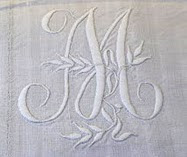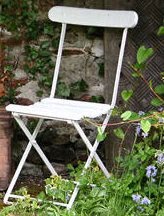Thursday, September 30, 2010
All Natural
Wednesday, September 29, 2010
Lovely Laura
A partnership is only as good as your partner. I am so thankful to have Laura Ingalls Gunn of Decor to Adore as my partner in Metis; we are different in some ways, yet so similar, and we share a bond having both lived in Europe. Wait until you see what lovely projects and decor Laura will create with vintage French linens, not to mention the decoration of our booth. It has been an easy creative collaboration; we are both very excited to launch Metis Linens on October 1~
~Andrea
Le Trousseau
Many people might think of the finest linens going into a bride's trousseau, something like this~
Undoubtedly a fantastic piece of hand-loomed linen & hand embroidery, seamed down the middle and with the beautiful contrasting thread over the letters~
In reality, the traditional trousseau was much more utilitarian, and its contents were very precise.
For the "household linens," the bride would bring:
18 pairs of sheets (top &bottom)
30 pairs of pillowcases
24 aprons
96 dishtowels
46 bath towels
60 table napkins, and
5 tablecloths
These would usually be "marked" with the initials of the husband's family name on the left, and the wife's family name on right right, separated by an "x" or a dot or a line. Here is an exception, his first & last initials, followed by her family name~
"Personal" linens or linge du corps would be the couple's clothing; both would be marked with their initials, his would be his first name and family name, again with a dot or cross or star in between~
and hers would be her first name and husband's family name; she would also bring the following items with her~
24 shirts
12 pantaloons
2 combinations (shirt +pantaloons?)
8 corset-hiders (short little shirts)
8 skirts
2 matinees or morning coats
48 hankies
18 pairs of undergarments
All of this would be assembled by the girl and her mother, over approximately a decade, prior to marriage.
But as time went on, the traditional trousseau rules loosened. You started to see variations, including numbers alone~
Here a dish towel is stamped and dated~
The monograms were used across France, as we know from certain fabrics which are clearly associated with certain regions; here a beautiful 19C toile from the area around Arles, in Provence~
You saw a magnificent example of this fabric recently in Veranda Magazine, the blue check cloth layered on the dining table of the over-the-top cover house in Provence; these three cloths are men's kerchiefs~
We found these at the Paris Flea, and the dealer noted as well that she had rarely seen such fine and tiny embroidery, on a man's item, no less~
Many items of course are never marked or monogrammed; we will stock unmarked and single items as well as sets; though an assortment of similar dishtowels look dreamy too; these are in the pile to go to the lavoir so excuse a few wrinkles~
Put a ribbon or napkin ring (or here, a French curtain ring) around a set of mismatched ones....
...and you have a very interesting and conversation-worthy napkin.
All of these items will be for sale at our Rose Bowl "store" on Sunday, October 12th. Find us in the Antiques section, space A03.
More on our linen sets soon~
Monday, September 27, 2010
Petit Monogram
Sunday, September 26, 2010
Welcome to Metis
Two blogger friends got talking about the linens of France. Why don't we see more of these classic fabrics in the U.S.? Especially metis, a blend which combines the softness of cotton and the durability of linen. There are some fantastic new linens available on the market, and they look great mixed in with a little vintage....and a business idea was born.
So, let's have fun with vintage French linens including sheeting (for upholstery, drapery or myriad other uses), kitchen towels, napkins and tablecloths~
Let's throw in a few French antiques, and see where our creative inspiration will take us....
Let's keep it simple, with lots of textural objects, and the things we each know and love....baskets and fabrics & craft projects...we have so much in store...
We aim to keep it fresh, keep it reasonable, and keep it authentically French. Stay tuned for lots of fabulous merchandise from a recent trip to France! Please come visit us at the October 10th 2010 Rose Bowl flea market for our first day of sales; our merchandise will also be available at Oma Talley's Cargo & Company showroom at the StoneMill Design Center, 2915 Red Hill Avenue, Costa Mesa CA.
New merchandise and craft ideas will always be available on our blog. We hope you will be as excited about the launch of Metis Linens as we are!







